VISHRAMBAUG WADA, PUNE:
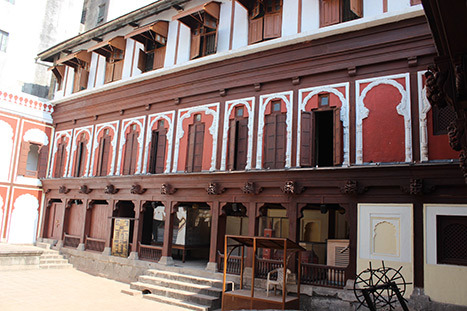
To give your eyes a treat of the impressive woodwork, the next on our list is the Vishrambaug Wada in Pune. Wada is a term referred to as the traditional residence of Marathas. Among the many Maratha structures, this one grabs attention for its opulence and intricate wooden work, unlike the other structures constructed by Marathas with simplistic designs. Built in the 19th century, the magnificent three-storeyed mansion was completed in six years and is also called Teen Chowki Wada. It was the preferred residence of the last Peshwa, Bajirao, and has many halls with admirable work of art. While the beautifully carved balconies and heavy wood pillars adorn the facade, wooden window shutters and a staircase add to the inner courtyard's beauty. You will be surprised to see the finely carved animal structures and their appropriate placement on the building.
The structure had to bear the destruction due to arson in 1871 but was later restored to its original charm. Only a part of the mansion is open to the public today and the main highlight of the building that immediately seeks ones attention is its intricately carved balcony and the entrance.
HIDIMBA TEMPLE, MANALI:
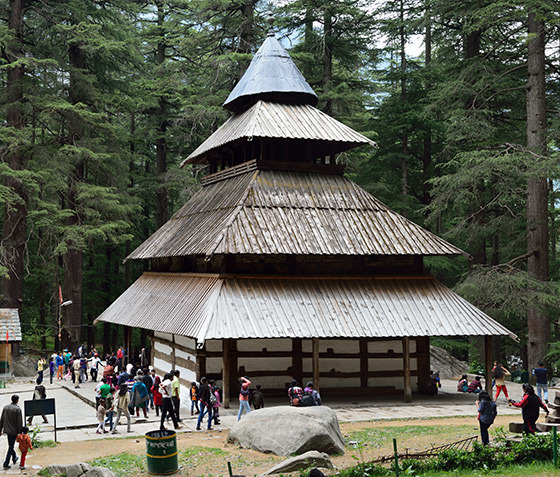
The structures built in any region speak a lot about the vicinity, the climatic conditions and locally available resources. Hidimba temple in Manali (Himachal Pradesh) is one such example, which is surrounded by a cedar forest and boasts of wooden architecture. This pagoda styled temple was built in the 16th century and depicts some elements resembling the Buddhist monasteries.
The temple is raised in a pyramidal-shape with four-tiered square roofs rising one above the other and covered with timber. With wooden doorways and finely carved windows it was constructed around a cave shrine, where Goddess Hadimba is believed to have meditated.
LEGEND BEHIND THE TEMPLE: The legend connects it with the epic Mahabharata, wherein Bhima (one of the Pandavas) married Hadimba during his exile. After the exile was over, Hadimba chose to stay back here and meditate. Her dedication pleased the Gods, and they bestowed her status of a Goddess.
WONDERS OF LADAKH:

The most common thing one would notice among the places with prominent wooden structures is the abundant availability of wood due to the nearby forests which are sustained by favourable climatic conditions and sufficient rains. Contrary to this, the mountains of Ladakh are barren as a desert with no vegetation at all. Despite scarcity of wood, one can still find ample usage of wood in the structures. Thanks to the neighbouring region of Kashmir that influenced the art here. The artisans here have wisely used stones and bricks for external walls of multi-storied houses while the wood is used for roofs, beams, and pillars. One can see such architecture in the Old Palace of Leh, which has exterior walls built of bricks and stones but has a wooden structure from inside. A similar kind of layout can be seen in Stok Palace, which has 77 rooms in a 04 storeyed structure. Numerous monasteries and old houses in the Ladakh region can be seen built on similar lines.
Boasting the oldest type of wooden architecture, Alchi is a true treat to the eyes for those keen to see wooden wonders. The admirable artwork of this Tibetan styled architecture has extensive wood carving in interiors. A complex of monasteries and chortens, Alchi monastery, is famous for its paintings. The wooden architecture of 03 storeyed Sumtseg (one of the structures inside the Alchi complex) which is unique to this monastery is enough to leave anyone spellbound.
The above illustrated some of the exemplary wooden structures that can be seen in India. But as the bricks and blocks replaced the wood, it still remained an integral part of the structures. With shrinking forests and changing times, wood artisans slowly shifted their skill to various other artefacts and woodwork ranging from carved pillars to latticed screens found its place in concrete structures. These also included the ones to adorn home décor, furniture etc. Different regions in India specialize in different wooden artefacts dependent upon the availability of wood in that region. Let us now introduce some of the regions and their specialized wooden crafts.
KASHMIR:

The easy availability of walnut trees in Kashmir was well utilized by the local craftsmen, who popularized the local wood art of ‘Kashmir Walnut Wood Carving’ worldwide. The characteristics of the walnut wood are its durability, hardness, its close grain and even texture that gave the local artisans enough flexibility to chisel out fine and detailed work, thus making the wood from walnut trees their ideal choice. Many decorative and utilitarian products carved out of this wood exhibit artisan's high degree of skill, craftsmanship, and attention to detail. Motifs are inspired by the natural environment of the surroundings.
The craft not only shows the labour behind the art but the artisan's patience as well. One will be surprised to know that artisans use the wood of the trees which are over 300 years old.
A TIP: Like Kerala, one will find extensive use of wood in Kashmir, where ceilings, balconies, windows, and even walls of the houses can be seen made up of wood. Another admirable wood craft unique to Kashmir is houseboat, which is completely made of wood (from cedar and walnut trees). These floating houses on beautiful Dal Lake and Nagin Lake are nothing less than a hotel. In comparison to the houseboats of Kerala, these houseboats are not used to travel but staying in these stationary marvels on the lake is a different experience altogether that one should not miss during a visit to Kashmir - A paradise on earth.
SAHARANPUR:
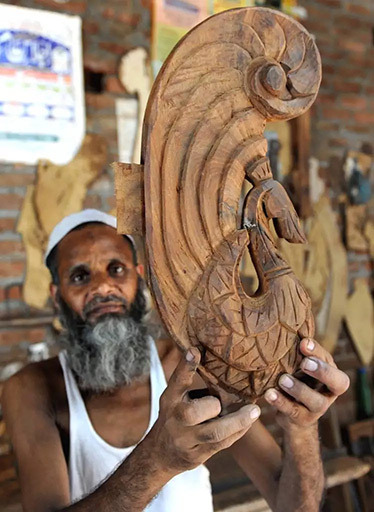
Artists kept on migrating from one place to another, which increased the reach of the art forms and thus also bringing variations influenced by the native flavor of that place. Similar is the case with wood carving in Saharanpur (Uttar Pradesh).
Located almost midway between Delhi (Approx. 195 kms) and Rishikesh (Approx. 112 kms), the wooden art of Saharanpur is around 400 years old. The brass inlay in the wood is what makes the art unique here. Different parts of the cut wood are crafted and inlayed with brass and then polished to combine into master pieces. The art is passed on from generation to generation, but still one can observe the Kashmiri influence through the motifs similar to those used in Kashmir.
While the carved products range from kitchen use to decorative, the most popular are wooden partitions or screens for rooms, intricately carved dining table and chairs, service trolleys, wooden boxes with inlay work and much more. The wood preferred for this art is Sheesham, and for this reason, Saharanpur is also called Sheesha wood village. The craft of the city is renowned internationally, engaging more than one hundred thousand local artisans and with a demand worldwide.
NORTHEAST INDIA:
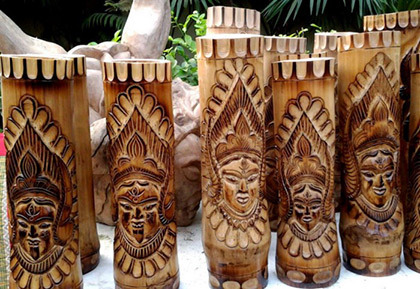
The woodcraft of northeast India comprising seven sister states of Arunachal Pradesh, Assam, Manipur, Meghalaya, Mizoram, Nagaland and Tripura has been a long tradition that bears the marks of numerous tribal communities residing in this area.
During a visit to this area, one will come across numerous wood artisans belonging to different tribal communities such as the Monpa, Nocte, Konyak, Phom, Khamti, Wancho, Tanga, Naga etc. working with their primeval tools. These artisans are renowned for their skill in wood carving and produce articles such as traditional carvings associated with head-hunting, ceremonial masks, drums sculpted from a single log of wood, wooden images of Lord Buddha, massive wooden panel with carvings depicting objects of art as well as those of ritual and service value, wooden dishes including utensils, bowls, cups as well as the art work that adorns the village gates and house posts.
Cane and Bamboo are also integral to the craftsmanship here as the local forests boasts of an abundant produce of a variety of them. The wood craft with Bamboo and cane is used to make articles such as cradles, mats to hats (such as the Assamese japi), jewellery, musical instruments, baskets, lampshades etc.
There are innumerable wooden wonders spanning length and breadth of India. Chettinad is one such town (not mentioned above) with numerous mansions boasting wooden art and abundant usage of carved wooden sculptures and pillars, including Burma's teak that is sure to grab ones attention. Intricate wood work can also be seen in the indigenous wooden toys of India that has its own mark.
It is no justice to sum up the ever-beautiful wooden wonders of India in just a few words, as India boasts of innumerable styles and masterpieces. We are glad to have tours where we not only take you to these and other similar beautiful places but also let you meet the artisans behind these traditional art forms of our culture!


 The visit to the palace makes a perfect day excursion from the nearby beach destination of Kovalam and with an additional 01 hour drive (around 40 kms) one can also explore the southernmost tip of the country, Kanyakumari, where the Arabian Sea and Indian Ocean merge. Watch the intricate wooden work at Padmanabhapuram Palace in this short video.
The visit to the palace makes a perfect day excursion from the nearby beach destination of Kovalam and with an additional 01 hour drive (around 40 kms) one can also explore the southernmost tip of the country, Kanyakumari, where the Arabian Sea and Indian Ocean merge. Watch the intricate wooden work at Padmanabhapuram Palace in this short video.
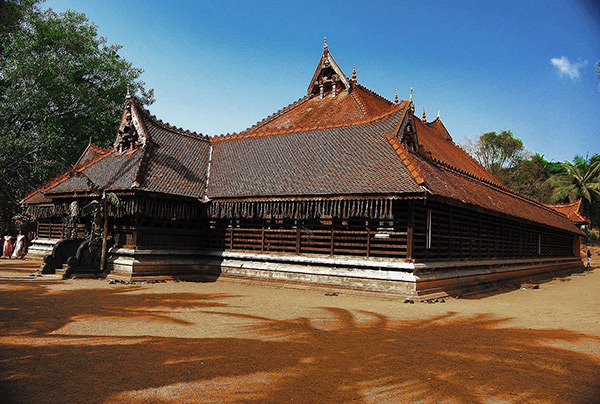 To cite a few examples, the height of the stage is not raised too much like usual stages. None of the pillars obstruct the view of the stage. An opening is facilitated on the either side of the Koothambalam to avoid echo and the structure is constructed in such a way so as to avoid distractions and noises from outside.
To cite a few examples, the height of the stage is not raised too much like usual stages. None of the pillars obstruct the view of the stage. An opening is facilitated on the either side of the Koothambalam to avoid echo and the structure is constructed in such a way so as to avoid distractions and noises from outside.
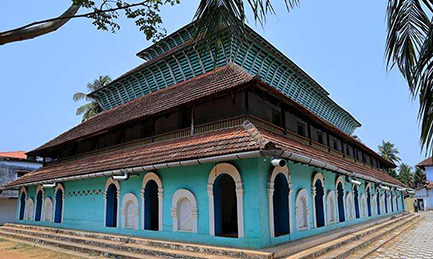 The next on our list is a mosque, which is completely contrary to the mosques structured with minarets and cupolas. This four-storeyed mosque is built in Kerala style architecture with carved ceilings, doors, gopuram like arches and with a generous usage of wood. Another contrary feature is the water ponds attached to its complex like of those in Hindu temple precincts. The wooden structure having 24 carved pillars and 47 doors was built in the 14th century by a muslim merchant with five storeys. In the 1510 arson, it was partially burnt by Portuguese but later restored much to its original charm. The incident also highlights the communal harmony in the region in those times, as the Hindu ruler avenged the Portuguese for this intentional destruction. One among the few surviving mosques of medieval times, this culturally, historically, and architecturally important monument can accommodate as many as 400 devotes at any given point of time. While the first and second floors display more of the roof than the verandah walls, the third and fourth floors exhibit the great latticed screen walls, which also allow only partial sunlight to enter.
The next on our list is a mosque, which is completely contrary to the mosques structured with minarets and cupolas. This four-storeyed mosque is built in Kerala style architecture with carved ceilings, doors, gopuram like arches and with a generous usage of wood. Another contrary feature is the water ponds attached to its complex like of those in Hindu temple precincts. The wooden structure having 24 carved pillars and 47 doors was built in the 14th century by a muslim merchant with five storeys. In the 1510 arson, it was partially burnt by Portuguese but later restored much to its original charm. The incident also highlights the communal harmony in the region in those times, as the Hindu ruler avenged the Portuguese for this intentional destruction. One among the few surviving mosques of medieval times, this culturally, historically, and architecturally important monument can accommodate as many as 400 devotes at any given point of time. While the first and second floors display more of the roof than the verandah walls, the third and fourth floors exhibit the great latticed screen walls, which also allow only partial sunlight to enter.
 To give your eyes a treat of the impressive woodwork, the next on our list is the Vishrambaug Wada in Pune. Wada is a term referred to as the traditional residence of Marathas. Among the many Maratha structures, this one grabs attention for its opulence and intricate wooden work, unlike the other structures constructed by Marathas with simplistic designs. Built in the 19th century, the magnificent three-storeyed mansion was completed in six years and is also called Teen Chowki Wada. It was the preferred residence of the last Peshwa, Bajirao, and has many halls with admirable work of art. While the beautifully carved balconies and heavy wood pillars adorn the facade, wooden window shutters and a staircase add to the inner courtyard's beauty. You will be surprised to see the finely carved animal structures and their appropriate placement on the building.
To give your eyes a treat of the impressive woodwork, the next on our list is the Vishrambaug Wada in Pune. Wada is a term referred to as the traditional residence of Marathas. Among the many Maratha structures, this one grabs attention for its opulence and intricate wooden work, unlike the other structures constructed by Marathas with simplistic designs. Built in the 19th century, the magnificent three-storeyed mansion was completed in six years and is also called Teen Chowki Wada. It was the preferred residence of the last Peshwa, Bajirao, and has many halls with admirable work of art. While the beautifully carved balconies and heavy wood pillars adorn the facade, wooden window shutters and a staircase add to the inner courtyard's beauty. You will be surprised to see the finely carved animal structures and their appropriate placement on the building.
 The structures built in any region speak a lot about the vicinity, the climatic conditions and locally available resources. Hidimba temple in Manali (Himachal Pradesh) is one such example, which is surrounded by a cedar forest and boasts of wooden architecture. This pagoda styled temple was built in the 16th century and depicts some elements resembling the Buddhist monasteries.
The structures built in any region speak a lot about the vicinity, the climatic conditions and locally available resources. Hidimba temple in Manali (Himachal Pradesh) is one such example, which is surrounded by a cedar forest and boasts of wooden architecture. This pagoda styled temple was built in the 16th century and depicts some elements resembling the Buddhist monasteries.
 The most common thing one would notice among the places with prominent wooden structures is the abundant availability of wood due to the nearby forests which are sustained by favourable climatic conditions and sufficient rains. Contrary to this, the mountains of Ladakh are barren as a desert with no vegetation at all. Despite scarcity of wood, one can still find ample usage of wood in the structures. Thanks to the neighbouring region of Kashmir that influenced the art here. The artisans here have wisely used stones and bricks for external walls of multi-storied houses while the wood is used for roofs, beams, and pillars. One can see such architecture in the Old Palace of Leh, which has exterior walls built of bricks and stones but has a wooden structure from inside. A similar kind of layout can be seen in Stok Palace, which has 77 rooms in a 04 storeyed structure. Numerous monasteries and old houses in the Ladakh region can be seen built on similar lines.
The most common thing one would notice among the places with prominent wooden structures is the abundant availability of wood due to the nearby forests which are sustained by favourable climatic conditions and sufficient rains. Contrary to this, the mountains of Ladakh are barren as a desert with no vegetation at all. Despite scarcity of wood, one can still find ample usage of wood in the structures. Thanks to the neighbouring region of Kashmir that influenced the art here. The artisans here have wisely used stones and bricks for external walls of multi-storied houses while the wood is used for roofs, beams, and pillars. One can see such architecture in the Old Palace of Leh, which has exterior walls built of bricks and stones but has a wooden structure from inside. A similar kind of layout can be seen in Stok Palace, which has 77 rooms in a 04 storeyed structure. Numerous monasteries and old houses in the Ladakh region can be seen built on similar lines.
 The easy availability of walnut trees in Kashmir was well utilized by the local craftsmen, who popularized the local wood art of ‘Kashmir Walnut Wood Carving’ worldwide. The characteristics of the walnut wood are its durability, hardness, its close grain and even texture that gave the local artisans enough flexibility to chisel out fine and detailed work, thus making the wood from walnut trees their ideal choice. Many decorative and utilitarian products carved out of this wood exhibit artisan's high degree of skill, craftsmanship, and attention to detail. Motifs are inspired by the natural environment of the surroundings.
The easy availability of walnut trees in Kashmir was well utilized by the local craftsmen, who popularized the local wood art of ‘Kashmir Walnut Wood Carving’ worldwide. The characteristics of the walnut wood are its durability, hardness, its close grain and even texture that gave the local artisans enough flexibility to chisel out fine and detailed work, thus making the wood from walnut trees their ideal choice. Many decorative and utilitarian products carved out of this wood exhibit artisan's high degree of skill, craftsmanship, and attention to detail. Motifs are inspired by the natural environment of the surroundings.
 Artists kept on migrating from one place to another, which increased the reach of the art forms and thus also bringing variations influenced by the native flavor of that place. Similar is the case with wood carving in Saharanpur (Uttar Pradesh).
Artists kept on migrating from one place to another, which increased the reach of the art forms and thus also bringing variations influenced by the native flavor of that place. Similar is the case with wood carving in Saharanpur (Uttar Pradesh).
 The woodcraft of northeast India comprising seven sister states of Arunachal Pradesh, Assam, Manipur, Meghalaya, Mizoram, Nagaland and Tripura has been a long tradition that bears the marks of numerous tribal communities residing in this area.
The woodcraft of northeast India comprising seven sister states of Arunachal Pradesh, Assam, Manipur, Meghalaya, Mizoram, Nagaland and Tripura has been a long tradition that bears the marks of numerous tribal communities residing in this area.
 We can conduct a virtual destination awareness training program for your team or yourself or a virtual tour for your clients. Let us know the destination of your interest along with your convenient date / time and we will be happy to set up a program for you.
We can conduct a virtual destination awareness training program for your team or yourself or a virtual tour for your clients. Let us know the destination of your interest along with your convenient date / time and we will be happy to set up a program for you.

